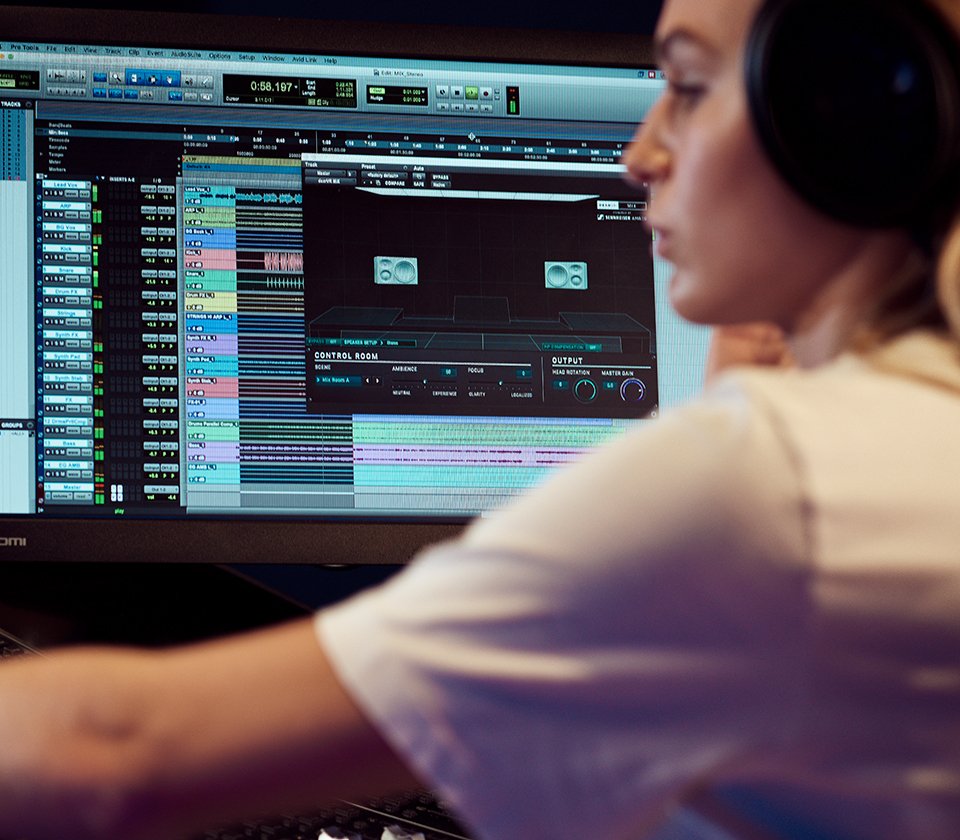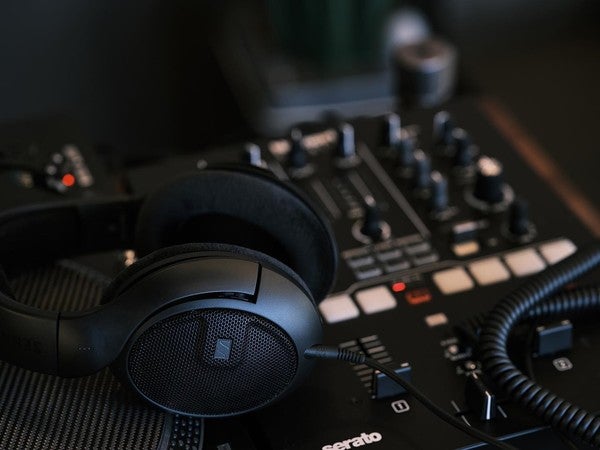Audio product names usually contain an esoteric combination of numbers and letters. It’s easy to sound like an audiophilic elitist when asking someone whether they prefer, say, the MKH 8060 or the MKH 8070. But in the case of the Sennheiser HD 400 PRO headphones, the product name is at least somewhat illustrative.
PRO is not an acronym—these are professional-standard studio headphones. This means a few things. First, although you don’t need to be a professional engineer to consider buying a pair, the audio quality, depth and transparency of the 400 PROs will significantly upgrade your studio set-up.
Second, the 400 PROs are designed to be used in the studio (or your closest equivalent) and not on the go. The attached cable has a 3.5 mm jack plug (and a 6.3 mm adapter), so there’s nothing to stop you using them elsewhere. But open ear cups are integral to the design, meaning these headphones are not equipped to block out background noise.
Third, the 400 PROs are reference headphones. They exist to give audio engineers a realistic idea of how the audio they’re mixing will sound to the average listener. They’re not supposed to be the bassiest, brightest or most spatially capacious headphones on the market. In the words of Sennheiser, the idea is that “what goes in is what comes out.”

So, what do they sound like?
The primary objective behind the Sennheiser HD 400 PROs is to offer mix engineers an unadulterated audio experience. In this, Sennheiser have succeeded. We’ve all been there: mixing all through the night and starting to feel like Chris and Tom Lord-Alge’s surrogate sibling, only to play the song in your car and realise you’ve forgotten to include the bass track.
There’s no danger of that happening with the 400 PROs. The sound is clear, natural and distinct. It mightn’t sound like glowing praise, but neutral sound reproduction is a tremendous asset when referencing a mix and assessing the impression it’ll make on audio laypeople.
Love Music?
Get your daily dose of everything happening in Australian/New Zealand music and globally.
Transparent sound
In the simplest terms, transparent sound is the opposite of confined (or isolated) sound. If you spend too much time wearing closed-back, noise-cancelling headphones, you begin to feel detached from reality. That’s not always a bad thing, but it’d be a mistake to assume everyone else will enjoy such an isolated listening experience.
All mixing engineers develop methods for gauging the quality of a mix as they go, whether it be waveform analysis; back-to-back comparisons with other songs; jumping between headphones and speakers; bouncing down and listening through laptop speakers; or cranking the mix on a car stereo.
The goal of these activities is to get some distance from the deep nerdiness mixing necessitates and anticipate what the average listener will hear. That’s the advantage of the 400 PROs’ transparent soundstage—you’re still hearing the mix through high quality headphones that illuminate the dynamics and EQs, but you’re not completely sealed off from the world around you.

dearVR MIX
Since 2019, Sennheiser has been working with the audio software company, Dear Reality, whose founding motive was to maximise the potential of audio mixing using immersive audio products.
A primary example is Dear Reality’s dearVR MIX plugin. Company CEO, Christian Sander, explained that dearVR MIX was developed by building on “all the experience we’ve gained in the field of spatial audio” to create “the perfect virtual mix room for your headphones.”
By adding dearVR MIX to your DAW, you can trust the sound coming through your headphones, whether you’re in a world-class stereo mix room or holed up in a budget motel. Dear Reality’s spatial audio innovation lets you choose between three adjustable, virtual reference mix rooms, including four mono and stereo loudspeaker positions.
dearVR MIX also prevents mix engineers from having to bounce down and reference mixes in a range of common listening scenarios. How? The plugin includes six precisely-modelled acoustic environments; namely, the car, club, home theatre, kitchen, living room and stadium.
Open ear cups
The HD 400 PRO headphones are open-backed, which lets air and ambient noise travel through the headphones when you’re wearing them. To optimise the mixing experience, you’ll want to be in a quiet room with no background clatter or chatter. Otherwise the people around you will hear the kick and bass sidechain you’re obsessing over and you’ll hear them talking, coughing and moving their chairs around.
There are benefits to referencing a mix with the addition of ambient sound—it could, perhaps, reveal EQ deficiencies or compression that attacks too hard—so by all means use the 400 PROs while on the treadmill, taking the dog for a walk or sitting in the airport lounge. But in terms of optimising the 400 PROs’ utility as a mixing tool, a silent environment is a must.

Coiled and straight cables
The HD 400 PRO headphones come with two separate cables that can be switched out at your leisure. There’s a 3m coiled cable with a 3.5mm jack plug and a 1.8m straight cable with a 3.5mm jack plug. There’s also a screw-on 6.3mm adapter that lets you plug straight into mixing desks, amps and the like.
The coiled and straight cables have their respective pros and cons. The coiled cable is heavier than the straight cable, but the coiled design prevents the cable from flapping around and getting caught on things while you work.
If you’re walking around with the headphones plugged into a portable device, the weight of the coiled cable can be an inconvenience. But if you’re running the headphones into a desk or interface while moving around and fiddling with things, the coiled cable lowers the chance of the jack being unceremoniously yanked from the desk.
It’s important to note that both cables have a lock-in function on the headphone end, just below the jack plug. This prevents any unintentional detachment of the cable, but you’ll need to be careful when switching from one to the other. Rotate the cable anti-clockwise before ripping it out (you’ll feel it unhook); once the new cable is inserted, turn it clockwise to lock it in place.
Lightweight, comfortable design
The Sennheiser HD 400 PRO headphones are great to wear. They’re big—even if you’re a relative Dumbo among your engineering friends, they’ll cover your entire ear—but they’re not bulky. The velour earpads sit securely on your ear without feeling like a constraint. There’s velour padding on the underside of the adjustable headband too, which means you can make it through an all-night mixing session without feeling like your head’s in a vice.
As you’d expect, the sound changes somewhat depending on where the headphones sit on your ears. Shifting positions can provide useful perspective on the highs and lows of a mix and it’s easily facilitated by the adjustable headband—the range of which exceeds that of your standard pair of headphones.



































